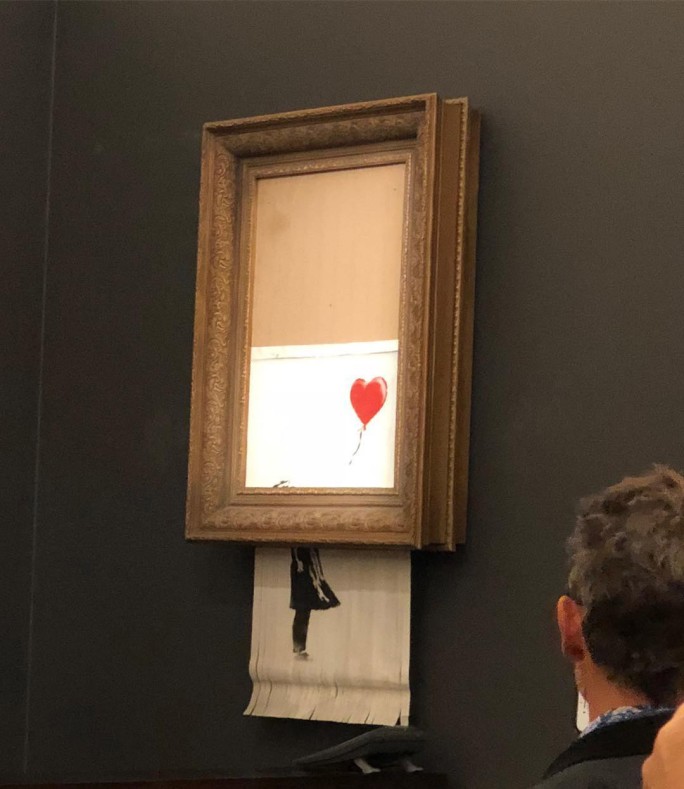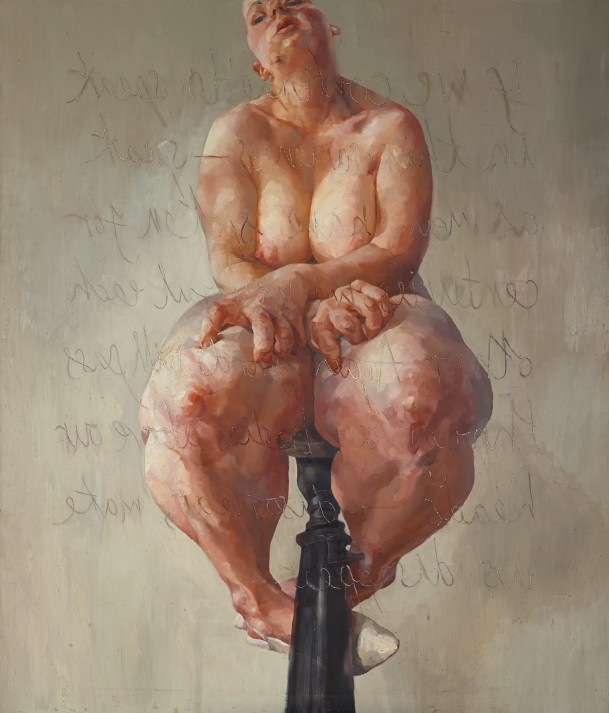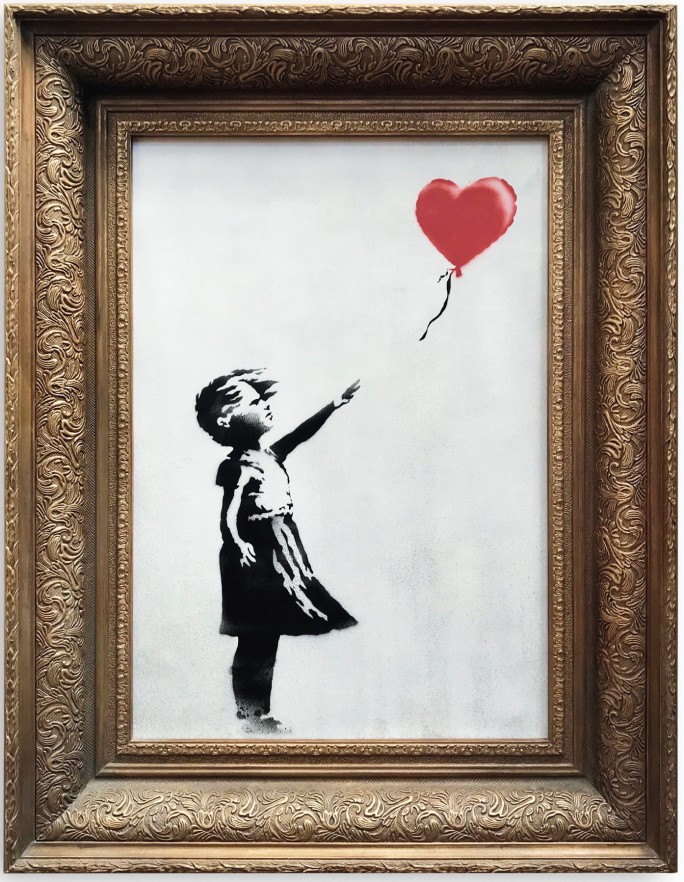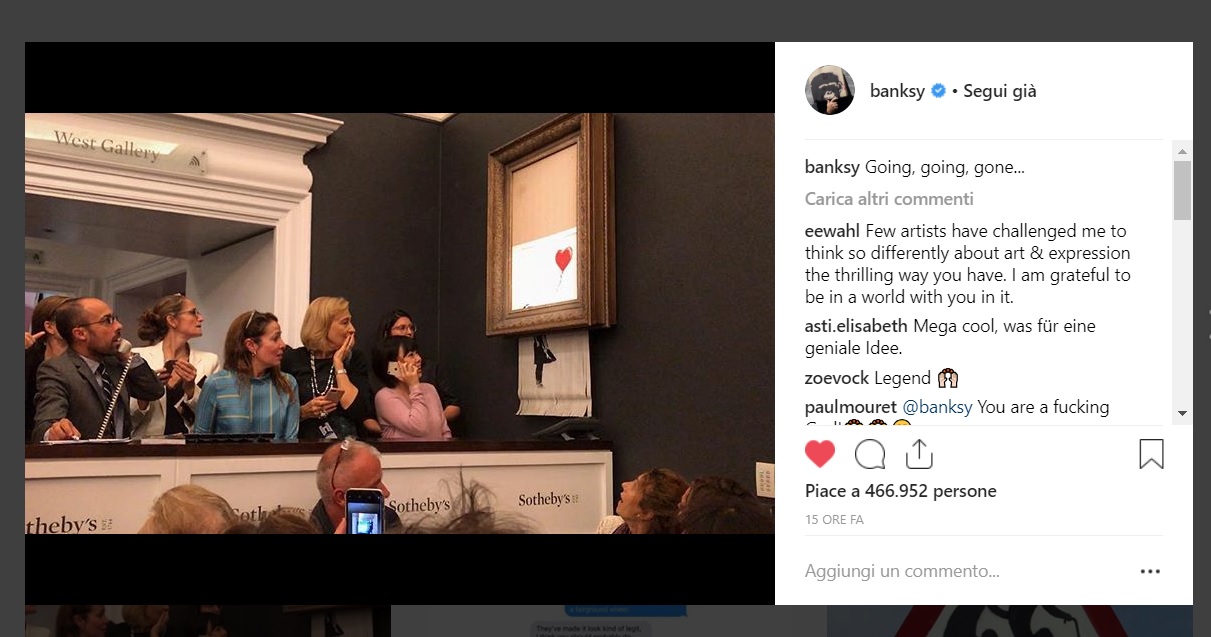Last Friday night, at Sotheby’s contemporary art auction, Banksy, the famous rebel street artist, made History. Update (19 October 2018): Banksy, in a clip posted to YouTube called “Shred the Love”, explains that he meant for the whole painting to be shredded, not just half of it. He further said in an Instagram post that Sotheby’s was not in on the prank. As to the new owner, he is far from a loser: The work has been renamed “Love is in the bin” by Pest Control, Banky’s official authentication body, and it is probably worth much more.
Sotheby’s had already scored with a remarkable sale, a Jenny Saville painting, Propped, going for over £9.5 million ($12.4 million). This was a record for a living female artist and a victory for all female artists whose work, compared to their male colleagues, is regularly undervalued by the market. Propped is a self-portrait by the artist and it is often seen as a message to empower women because of the quotation from a feminist French critic scribbled across the canvas (written in reverse, hence only legible when viewed in a mirror):
In the photo: Propped, by Jenny Saville. Source: Sotheby
At the close of the session, Banksy’s iconic Girl with Balloon, which had been estimated at £300,000, soared to an unprecedented €1.04 million ($1.4 million).
In the photo: Girl with Balloon by Banksy , in its heavy gilded frame shown at Sotheby’s Source: Sotheby
The hammer went down and people got up to leave. An alarm unexpectedly sounded and Banksy’s painting, still attached to the wall, started to self-destruct. A shredder, hidden in its heavy gilded frame, whirred and gobbled up the painting, shredding the little girl into long vertical strips and sparing only the heart-shaped balloon:
Banksy immediately commented on Instagram(he’s not on Facebook or Twitter), much to his fans’ delight, “Going, going, gone…”
Alex Branczik, Sotheby’s senior director and head of contemporary art in Europe took it in stride. “It appears we just got Banksy-ed,” he said. It was certainly a media coup for the artist, and art critics rushed to say that the artwork was probably worth more in its shredded state than in the original intact one. Much more according to Joey Syer, co-founder of www.MyArtBroker.com, who told The Evening Standard “That shredded artwork could now have doubled in value. Girl with Balloon is one of the most iconic images of recent times. It’s seen some of the sharpest price increases over previous years with signed/unsigned prints and canvass showing an average of +20% yoy. Prices now are regularly exceeding £115,000 for signed authenticated prints.”
Ten hours later, no doubt to make sure he was not misunderstood, Banksy added another post on Instagram quoting Picasso: “The urge to destroy is also a creative urge” and explaining in the video how he built a shredder into a frame should one of his artworks ever go to auction:
Banksy has now entered the pantheon of art pranksters, along with famous artists like Marcel Duchamp known for his Fountain (1917) made from a porcelain urinoir , Piero Manzoni known for his Artist’s Shit (1961) and Chris Ofili for his elephant dung used, inter alia, to frame his Holy Virgin Mary (1996).
The UK Guardian titled: “Banksy auction prank leaves art world in shreds”. In shreds? Not quite. Don’t believe these are worthless pranks. Duchamp’s and Manzoni’s work both made it in world-class museums and Ofili’s dung-decorated Madonna sold for $4.6 million in 2015.
No doubt about it, things are looking up for the mysterious Banksy – a “guerilla artist” known for his politically controversial stenciled works and who’s already widely popular, not least because nobody knows who he is (probably from Bristol, born in 1974).
But there’s more to this than a mere prank.
Banksy’s reference to Picasso’s quote is highly relevant: It captures the essence of what drives Art today. And it could be described in one term: Creative destruction. That is what Picasso meant and what Banksy means too. Creative destruction, in German: schöpferische Zerstörung, also known as Schumpeter’s gale, from the Austrian-American economist Joseph Schumpeter. This is a concept he developed in his book Capitalism, Socialism and Democracy (1942) to explain the business cycle and how technological innovation can change economic structures, destroying them and rebuilding them anew.
This is not the first time the term is used in the arts. It has often been used in literature (see, for example, Philip Fisher’s Still the New World: American Literature in a Culture of Creative Destruction, Harvard U. Press, 2000) and it is certainly applicable to the visual arts. The question is: How much needs to be destroyed before something new can be built? And how do you distinguish between destruction and creation?
That is Banksy’s challenge for us.
EDITOR’S NOTE: THE OPINIONS EXPRESSED HERE BY IMPAKTER.COM COLUMNISTS ARE THEIR OWN, NOT THOSE OF IMPAKTER.COM
Featured Image: Girl with Balloon shredded at the close of Sotheby’s auction, 5 October 2018 Source: Sotheby













